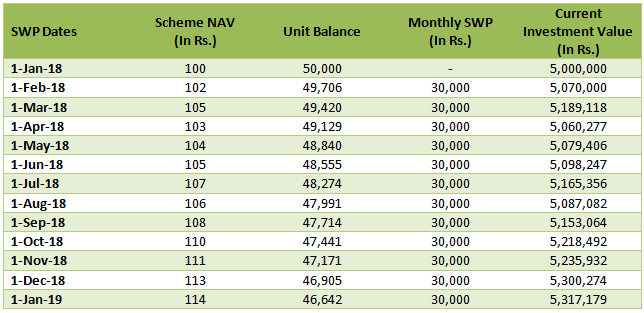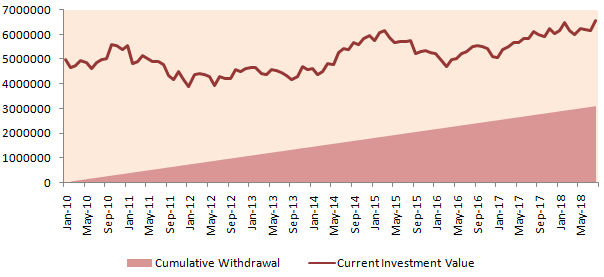Meeting your income needs through Mutual Fund Systematic Withdrawal Plan

Bank fixed deposits paying monthly interest or post office monthly income schemes (MIS) are the traditional investment choices of investors who needed regular income from their investments. However, with fall in interest rates many retail investors are now shifting their attention to mutual funds, which historically have given far better returns than FDs over long investment tenors.
While mutual funds have traditionally been looked upon as wealth creating investments, they are also extremely useful investment options for regular cash flows. Dividend options of mutual fund schemes aim to distribute profits made by the scheme on a regular basis to investors and as such they can be a good investment choice for investors who need regular income.
However, investors should understand that even though fund houses may strive to continue paying dividends to investors, dividend rate per unit is not assured and even pay-outs are not guaranteed. This is because dividends are paid from accumulated realized profits of the schemes; if a scheme continues to pay dividends through a protracted market downturn, it may result in depleting its accumulated profit reserves and at some point of time, it may have to stop paying dividends to investors. Using mutual fund Systematic Withdrawal Plan investors can draw a fixed amount at regular intervals irrespective of market conditions and hence SWP is a relatively better choice for investors looking for regular cash-flows.
What is Systematic Withdrawal Plan in a Mutual Fund?
Systematic Withdrawal Plan (SWP) is an investment solution offered by mutual funds, whereby investors can withdraw fixed amount at pre-defined frequency from their investment in schemes offering such facility. The investor can opt for such facility through SWP registration. Based on the defined frequency /eligible amount specified by the investor, the fund house will redeem the units at prevailing NAVs and the amount will be credited to the registered bank account of the investor.
How Systematic Withdrawal Plan in a Mutual Fund work?
Suppose, you invested Rs 50 Lakhs in a mutual fund scheme at a NAV of Rs 100 per unit on January 1, 2018. You will be allotted 50,000 units. Let us assume that you need a monthly cash-flow of Rs 30,000 payable on the first day of every month. On February 1, if the scheme NAV is Rs 102, the fund house will have to redeem 294 units to generate Rs 30,000 cash-flow for you (please note that we have ignored exit loads for the sake of simplicity). You will be left with 49,706 units. Every month the requisite number of units will be redeemed based on prevailing NAVs to generate your monthly cash-flows. If NAVs increase less units will be redeemed and if they fall more units will be redeemed. The SWP will continue as long as you have sufficient unit balance or till the end date specified by you at the time of registration. The table below illustrates SWP unit balance and investment values every month (NAVs are purely illustrative).

The above is only for illustration purpose
How SWP can work over very long tenors?
In the illustration above, we have seen how the SWP worked over 12 months. If invested in the right asset type and scheme, SWPs can work for very long tenors. We will now illustrate how SWP can work over the very long tenors. The chart below shows the SWP performance of Rs 50 Lakhs invested in Nifty – 50 Total Returns Index (TRI) at the beginning of this decade (2010); the withdrawal amount is same as in the previous example, Rs 30,000 per month. We have chosen Nifty – 50 as the asset type because equity is the best performing asset class in the long term and Nifty represents the universe of the largest and most stable stocks in India.

Source: Nifty – 50 TRI data from National Stock Exchange
With an investment of Rs 50 Lakhs in Nifty 50 TRI you could buy 770 units of the index in 2010, when Nifty was at around Rs 6,500 (please note that this is purely to illustrate the benefits of SWP; Nifty is an index, not a mutual fund scheme, but the same principal can be applied to a scheme also). Every month you drew Rs 30,000 by redeeming units of Nifty at prevailing values and over the last 8+ years, you would have drawn more than Rs 31 Lakhs on a cumulative basis. The total number of units redeemed by you to generate your monthly cash-flows over the last 8+ years will be 357 units and you will be left with 419 units. However, over this period, the value of Nifty 50 TRI appreciated from 6,500 to 15,658 (CAGR of 10.8%). The value of your balance 412 units at current Nifty value will be more than Rs 65 Lakhs, Rs 15 Lakhs higher than your initial investment amount. Despite drawing Rs 31 Lakhs on a cumulative basis, your investment appreciated from Rs 50 Lakhs to Rs 65 Lakhs (as on September 10, 2018). Using SWP you can generate both regular cash-flows and capital appreciation, provided you have a moderate rate of withdrawal.
What should be the rate of withdrawal?
Rate of withdrawal is of crucial importance in SWP. The rate of withdrawal will of course be based on your cash-flow needs, but you should bear in mind that if you draw at a very high rate then you run the risk of depleting your units faster and your SWP can come to an end prematurely. How much should you withdraw? Logically speaking, if you want to continue your SWP for a very long period of time, your withdrawal rate should be lower than long term average return of the scheme. However, you should be more conservative with your withdrawal if you want to preserve your capital. In our view annual withdrawal rate should not exceed 7 – 8% of the investment amount. Once you have significant capital appreciation, you can increase the fixed SWP amount but it again should not exceed 7 – 8% of the current investment value.
What are the Tax Benefits of SWP?
Since SWP generates cash-flows by redeeming units, capital gains tax will come into play. You should know that tax will be levied only on the profit (capital gains) made on units redeemed during the financial year and not on your entire withdrawal amount. Capital gains taxation will be different for equity and non-equity schemes.
Withdrawals made within 12 months from the date of investment in equity funds (and equity oriented hybrid funds) will be subject to short term capital gains tax at the rate of 15%. It is better to start your withdrawals at least 12 months from the investment date. Profits made on units redeemed after 12 months will be tax exempt up to Rs 1 Lakh (every financial year). Profits exceeding Rs 1 Lakh in any financial year will be taxed at 10%. The Rs 1 Lakh tax exemption on long term capital gains in equity funds make SWP a more tax efficient income solution compared to mutual fund dividends (where 10% DDT is payable by the fund house).
Capital gains on withdrawals in debt funds made before 3 years from the date of investment will be taxed as per the income tax rate of the investor. Capital gains on withdrawals in debt funds made after 3 years from the date of investment will be taxed at 20% after allowing for indexation benefits. Indexation benefits can lessen the tax obligation of the investors considerably. For individual tax consequences, investors are requested to consult their tax advisors.
Conclusion
- SWP is a smart investment solution for investors to get regular cash-flows by making a one-time investment.
- SWP cash-flows are fixed and generated by redeeming a certain number of units at prevailing NAVs.
- SWP from equity funds is highly tax efficient due to long term capital gains tax advantage. SWP from debt funds is also very tax efficient due to effect of indexation benefits.
- Investors should bear in mind short term capital gains taxation and exit loads of schemes when planning their SWPs
- Finally, a moderate withdrawal rate is important for a SWP to be sustained over long tenors.
- If you plan your SWP well, you will not only get regular cash-flows but also potential capital appreciation over a sufficiently long investment horizon.
Mutual Fund Investments are subject to market risk, read all scheme related documents carefully.
#Wise With Edelweiss – An Investor Education Initiative by Edelweiss Mutual Fund.
EAML is amongst the fastest growing asset management companies, being an asset management subsidiary of Edelweiss Financial Services Ltd., one of Indias leading financial services group since last 21 years with a proven track record of quality and innovation. Edelweiss AML is present across 11 locations across the country. EAML offers a suite of differentiated asset management products and the unique knowledge proposition focusing on building a strong connect with Distributors and customers. At Edelweiss AMC, the aim is to come up with truly innovative ideas that doesnt exist today and bridge the gap between what investors want and what the industry has to offer.
Quick Links
Contact Us
- Toll Free : 1800 425 0090
- Non Toll Free : +91-40-23001181
- EMFHelp@edelweissfin.com
- distributor.amc@edelweissfin.com
POST A QUERY





